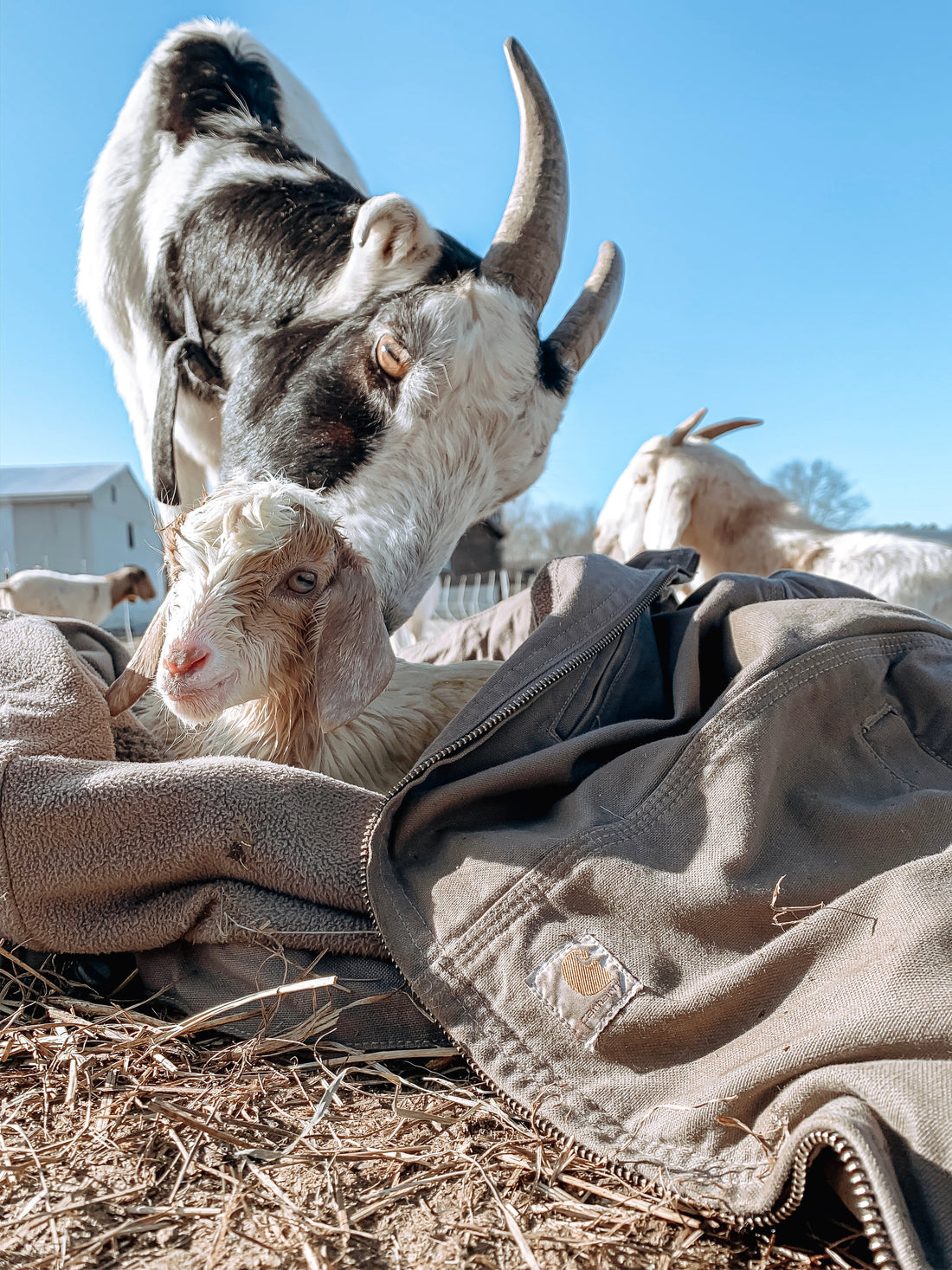We didn’t always supplement with Selenium and vitamin E through injection, in the beginning, we did what we had found through research prior to buying the goats and we offered free choice trace mineral blocks and loose minerals. Although the commercially produced feed also contained the required amount catered to a goat’s diet, it still wasn’t sufficient enough.
I remember numerous occasions where kids were born incredibly weak and couldn’t stand, let alone suckle to nurse - it’s just now occurring to me, that this was something that Faith struggled with at birth as well, and I’m only now connecting those two dots - not that treating her with BoSe at birth would have guaranteed she’d live forever, but had I known then what I know now... I firmly believe it would have made a difference in her overall health.
See, what I didn’t know in the beginning, was just how crucial it was for goats to have proper vitamins and minerals. Yes, I knew they were important. But between the free choice minerals, grain, hay, and pasture given the appropriate season, I didn’t think that they would require additional supplementation.
We are located on the Eastern coast of the United States (zone 7a), geographically a selenium deficient area. And although we offered supplements, our location as well as our well water, led to this and other vitamin and mineral deficiencies.
There are multiple sources that I reference when I’m in a bind, and Tennessee Meat Goats is probably one of my favorites. It’s full of useful information for those just starting out with a few goats as well as seasoned goat keepers such as myself.
I have linked the website below for anyone interested in saving additional resources, thanks for following along and enjoy!
-Liz
The following is from Onion Creek Ranch
SELENIUM AND VITAMIN E
Critical to Raising Healthy Goats
Selenium is an essential trace mineral present in the soil. In the United States, soil is generally selenium-deficient in parts of the Pacific Northwest, from the Great Lakes region to the New England states, and along the Eastern Seaboard into Florida. Local, state, and federal agricultural extension services usually maintain soil maps that indicate selenium levels. A Google search will also bring up maps of selenium-deficient areas in the USA. Because selenium levels can vary greatly within an area, testing the soil's selenium content is recommended. Soil is considered "selenium deficient" when there is less than 0.5mg of selenium per kg of soil. Because selenium is stored in the liver and kidneys and can be identified in blood, a complete blood count (CBC) test can be used to identify selenium levels in the goat's body.
Selenium in soil is absorbed by growing plants that are eaten by foraging/browsing goats. Proper selenium levels are necessary for goats to reproduce, lactate, give birth, urinate, and have properly functioning muscles. Selenium working with vitamin E helps develop and protect healthy brain cells, assists in thyroid function, helps the immune system function properly, and prevents cell wall damage. Symptoms of selenium deficiency are similar to those of Vitamin E deficiency. White Muscle Disease, also known as Nutritional Muscular Dystrophy, is a condition in which kids are too weak to stand or suckle at birth, they consistently cough, milk sometimes runs out of their nose after nursing, and they develop pneumonia because of muscle weakness in their lungs. In adults, abortions, stillbirths, retained placenta, or inability to conceive can be indicative of selenium deficiency.
Pen-fed goats can be more susceptible to selenium and vitamin E deficiency since they don't have access to forage plants containing them. High levels of sulphur in feed prevent selenium absorption. Proper levels of calcium in feed can help in selenium and vitamin E uptake. Selenium is routinely added to processed grain by feed mills, but the amount permitted by US law may be insufficient for some areas. Therefore, many producers obtain a veterinary prescription for injectable supplements (BoSe). Oral selenium supplements in gel form are available over the counter if you cannot obtain injectable BoSe. Injectable selenium tends to work better and faster, based upon my limited experience, but the availability of oral supplements is certainly better than going without. Do not use MuSe; it is a selenium supplement for horses and too strong for goats. Dosages vary by region and should be discussed with a knowledgeable vet, but the following is a general outline of how many producers supplement their goats to achieve adequate selenium levels: Annually before breeding season, all adults, including breeding bucks, are given injectable selenium (BoSe). Bucks should receive BoSe injections at least twice a year. Pregnant does are again supplemented with BoSe four to six weeks before kidding. Selenium-deficient dams produce selenium-deficient kids. Kids are injected with BoSe at birth, again at one month of age, and if the soil is very selenium deficient, injections are repeated at two and at three months of age. Use 1/4 cc BoSe for small-breed goat kids and 1/2 cc BoSe for medium-to-large-breed goat kids. Although BoSe is not approved for use in goats, producers generally use 2-1/2 cc per 100 pounds body weight for adult animals. I give BoSe into the muscle (IM). If you can find a qualified goat vet in your area, discuss your goats' needs in detail.
In extremely selenium-deficient areas, I know producers who use Mineral Max (aka Multi-Min) injections instead of BoSe. This product is a high concentration of four essential minerals (zinc, manganese, selenium and copper) in injectable chelated (slow-release) form and should be used sparingly and in smaller doses as the goat ages because it builds up in the fatty tissues. I would not give it to newborns and very young kids; I would use BoSe instead. Always give Mineral Max SQ (under the skin) because it stings the goat when given IM (into the muscle). Oral supplementation of vitamin E should be given in conjunction with Mineral Max injections. Mineral Max/Multi Min is is another product that is not labeled for goats and must be used under a qualified vet's prescription and supervision. In the years 2011 and 2012, many areas of the USA have experienced either severe drought or too much rain. Both conditions can result in selenium deficiency where none existed previously. I have been using Mineral Max since the 2011 drought because my pastures have yet to recover. I follow the cattle dosage instructions for adult animals.
Selenium has a very narrow margin of safety. Goats require 0.2 parts per million of selenium, and the toxic level is 3 ppm. Some symptoms of selenium deficiency are identical to those of selenium toxicity. A doe's failure to conceive can be the result of either selenium deficiency or toxicity. Kidney failure, stillbirth, and abortions also may be attributable to either end of this spectrum. By contrast, hair loss in the beard and flank regions and cracks and deformities in horns and hooves may indicate too much selenium in the goat's diet. Over-concentrations of selenium occur in parts of North Dakota, South Dakota, Nevada, Idaho, California, Arizona, New Mexico, and adjacent states. See your local agricultural extension agent for information on concentrations in your area. Alkali-based soils allow plants to absorb selenium to levels toxic to goats, causing "alkali disease." Certain "indicator" plants reveal a toxic level of selenium in the soil. Some species of Astragalus (locoweed) indicate the presence of high levels of soil-based selenium. Goats actually become addicted to these plants if they are not completely removed from this forage.
Symptoms of severe selenium toxicity include impaired vision and staggering ("blind staggers"), rear legs which won't support the body, then muscle weakness in the front legs, and progressive weight loss. Each of these symptoms can also be symptoms of other illnesses, so the producer should determine his area's selenium conditions in advance to avoid an incorrect diagnosis. Once a goat has severe selenium toxicity, there is no known effective treatment. Removing the affected animal from the area where the problem occurred and performing supportive therapy is the best chance of saving the goat. Goats affected by selenium toxicity remain bright, alert, and are eating well up to the time of death.
Karin Christensen (www.goatbiology.com) has some great illustrations (both animated and still) as well as articles that are much more technical than I offer, if you are interested in the detailed biology of goats.
Suzanne W. Gasparotto, Onion Creek Ranch, Texas 6/10/12

